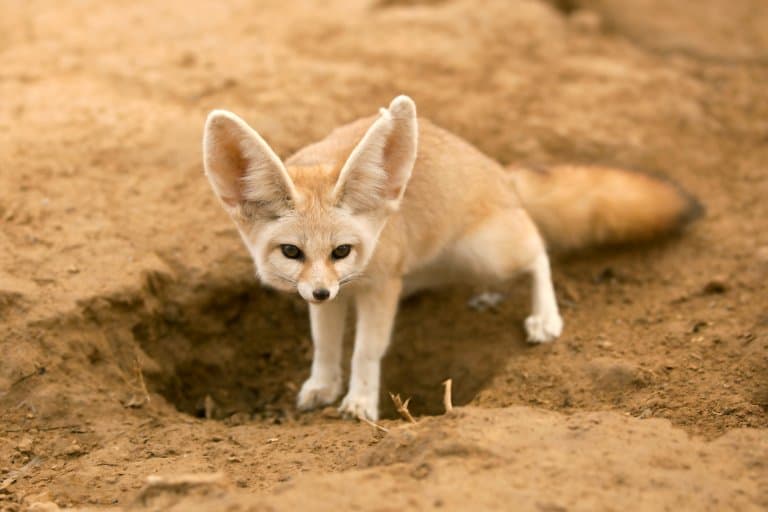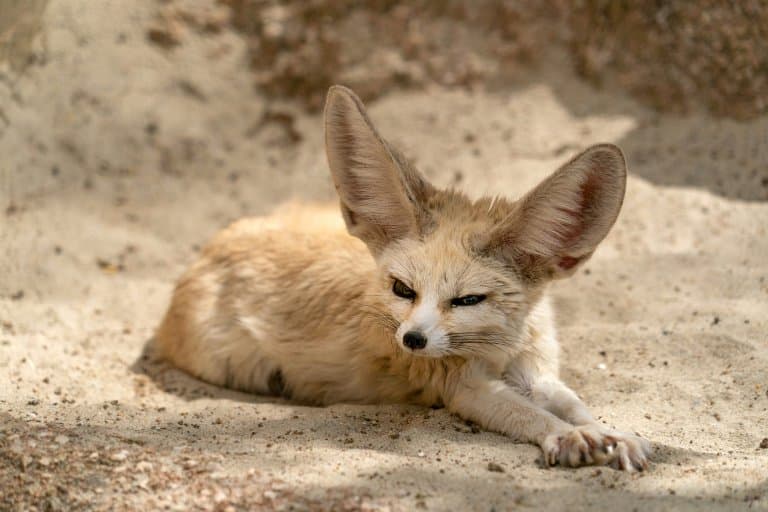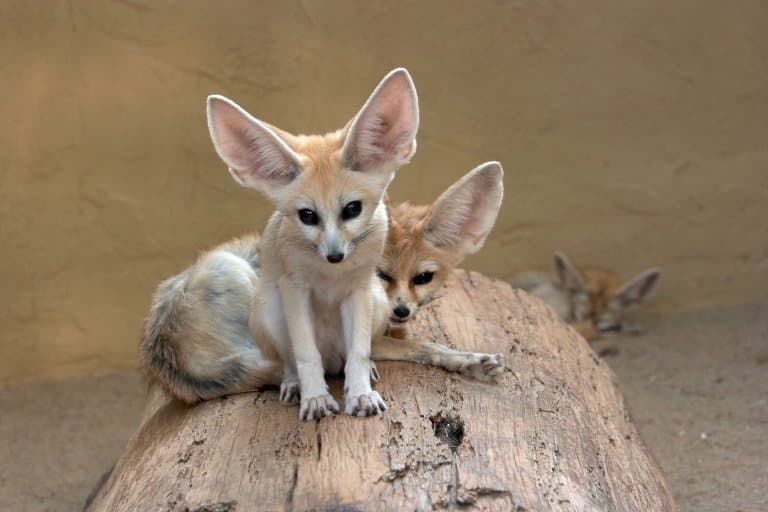Fennec Fox Profile
The fennec fox is the smallest of the world’s foxes, and can be found inhabiting sandy deserts and semi-deserts in North Africa. These small canids are prevalent throughout the Sahara from Morocco to Sinai and Arabia. They prefer sandy deserts and arid areas with scrub or desert grasses.
Fennec foxes are well adapted in order to inhabit the harsh environments in which they live. They have very dense hair, which protects them from the hot sun during the day and has a woolly undercoat to insulate them at night.
They also have extra hair on their feet – this helps protect their feet from the hot sand, and also acts like snowshoes, to give the creature traction when running on the sand. Their coats are a pale cream, with a black-tipped bushy tail. They have small, pointed faces, large eyes and extremely large ears.

Fennec Fox Facts Overview
| Habitat: | Sandy desert, arid grasslands |
| Location: | North Africa, Sahara |
| Lifespan: | Up to 11 years in human care |
| Size: | Head & body: 9-16 inches; tail: 7-12.5 inches |
| Weight: | 2.2 – 3.3lbs |
| Color: | Cream/pale tan, black tipped tail |
| Diet: | Omnivore |
| Predators: | Jackals, large mammals, large birds of prey |
| No. of Species: | 1 |
| Conservation Status: | Least concern |
Fennec foxes live in dens underground which they dig out using their feet. These dens can be complex: with multiple exits and entrances for safety, sometimes stretching for up to 10 metres in length, and up to 3 feet underground.
Occasionally dens from different family groups can be interlinking. Fennec foxes are predominantly crepuscular (most active at twilight), when they venture out from their cool underground dens to hunt and forage during the cooler hours of the day.
They are opportunistic eaters – eating plants, rodents, reptiles, eggs, and insects such as grasshoppers and locusts. They hunt at night, using their large ears to listen for prey. Fennec foxes are able to catch and kill prey larger than themselves. They are widely hunted for fur, and also for the exotic pet trade.
Females will give birth to one litter per year. Despite their cute appearance, male fennec foxes can show aggressive and territorial behaviours during mating season and will mark their territory with urine and faeces, just like other canines.
They will defend the females before and during the birth, and will bring food to the female for the first 4 weeks of motherhood. Fennec pups are born blind and their eyes open after around a week. They will nurse for about 10 weeks and become fully mature at 9 to 11 months.
Interesting Fennec Fox Facts
1. They have huge batlike ears
Fennec foxes are the smallest fox in the world, but they have surprisingly large ears – their ears can be up to half the size of their bodies! They have the largest ears in comparison to their body size of all species in the canid family.
These batlike ears help regulate their body temperatures in the heat of the desert by radiating heat away from their bodies. Their network of veins cool the blood and lower their temperature.
They also enable the fox to hear noises from prey living underground. During their nighttime hunting, the foxes will listen out for sounds coming from animals under the sand and will then use all four paws to dig through the sand to their prey. 1

2. The fennec fox can go for a long time without water
Also known as the desert fox, these tiny foxes are believed to be the only carnivore in the Sahara that is able to exist without requiring a freely available water source.
This is an adaptation that is seen in many desert dwellers, and it enables them to survive in these harsh habitats. Fennec foxes’ kidneys are adapted to conserve water and they are able to hydrate from the food they consume and from the dew that forms inside their dens at night.
Their small bodies also allow them to shed heat faster in the desert. 2
3. Fennec foxes are high jumpers
The fennec fox has been known to jump as high as 2 feet from a standing positive, and can leap lengths of up to 4 feet. This is impressive considering their small size and stature.
Their agility gives them an advantage when hunting prey or evading predators. Indeed, their two biggest threats are humans and eagle-owls, as they can often out-manoeuvre other land-based predators. 3
4. Fennec foxes are the palest of all foxes
Their light-coloured fur gives them great camouflage against the desert sands.

5. They use extreme panting to help regulate their body temperature
During the intense desert hear, the fennec fox’s breathing rate can increase from around 25 breaths per minute to a whopping 690 breaths/minute. This heavy panting helps keep their body temperature at a sustainable level. 4
6. Fennec foxes can help local farmers
Farming and agriculture is often threatened by rodents and insects such as locusts, which the fennec fox can help to control. Small carnivores like the fennec fox can play an important role in balancing the ecosystems in which they live.
7. They mate for life
Fennec foxes are monogamous, and a male and female couple will typically produce one litter per year, of between two and five pups. While the mother is nursing, the male will bring her food and acts as her protector during this time, as well as during the birth.
8. They are very social animals
Although most of what is known about fennec foxes has been observed while these animals are in captivity, it is seen that fennec foxes relish company: they live in tight-knit groups or families of up to 10 individuals, sometimes co-habiting with other families too.
They have also been observed engaging in play, even as adults. 5
9. Fennec foxes have a wide variety of communication sounds
These sounds can be described as barks, whimpers, squeaks, growls, chatters and howls. They frequently communicate with one another, both during play and to establish social rankings.
10. Fennec foxes are fast runners
Despite their diminutive size and small legs, fennec foxes can run surprisingly fast – up to 20 mph!
Fennec Fox Fact-File Summary
Scientific Classification
| Kingdom: | Animalia |
| Phylum: | Chordata |
| Class: | Mammalia |
| Order: | Carnivora |
| Family: | Canidae |
| Genus: | Vulpes |
| Species Name: | Vulpes Zerda |
Fact Sources & References
- “Fennec Fox”, Seaworld Parks & Entertainment.
- “Fennec Fox”, Smithsonian’s National Zoo & Conservation Biology Institute.
- “Fennec Fox Vulpes zerda”, San Diego Zoo Wildlife Alliance.
- “Fennec Fox”, National Geographic.
- “Fennec Fox (Vulpes zerda) Fact Sheet”, San Diego Zoo Wildlife Alliance Library.
